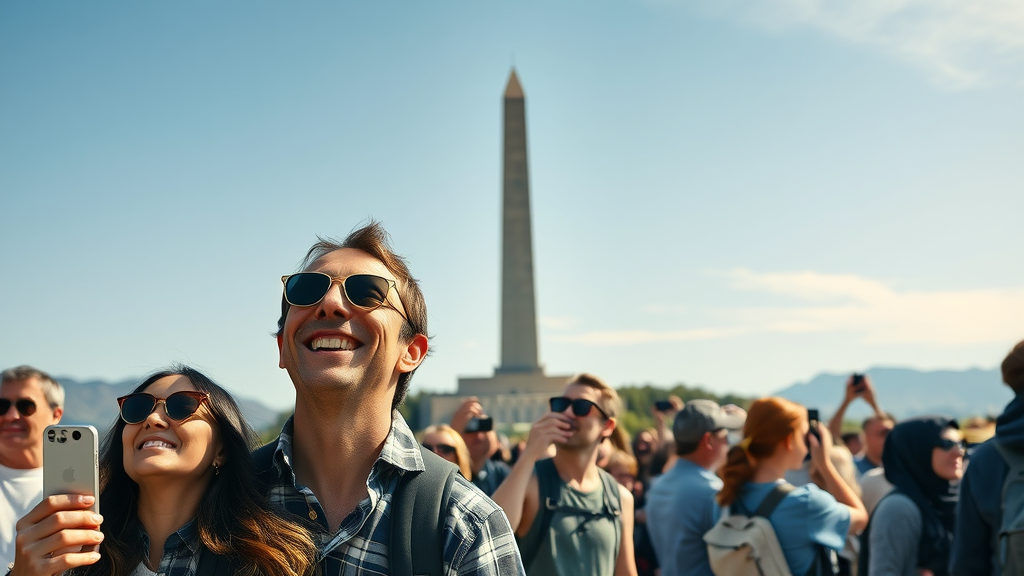Did you know that over 40% of Americans say they haven’t explored even half of their own country? While most visitors flock to famed cities and celebrated national parks, the true soul of tourism in the United States lies in its hidden gems—spectacular destinations and unique communities often overlooked by guidebooks. This editorial delves beyond the surface, unraveling the shifting trends, economic impact, and inspiring unknown wonders poised to shape the future of American tourism.
- Unique lesser-known destinations redefining travel in the United States
- How shifting trends and digital tools are influencing travel habits
- Insights into the economic and cultural impact of both national and international travel
- Predictions for the future of the U.S. tourism industry
An Evolving Landscape: The Current State of Tourism in the United States
The tourism in United States is undergoing an exciting transformation, responding to both global trends and local dynamics. From the vibrant streets of Los Angeles to the tranquil corners of rural America, the evolving tourism sector is more diverse and resilient than ever. According to Brand USA and data from organizations like Oxford Economics , both domestic travel and inbound international visits are rebounding post-pandemic, reflecting changing traveler priorities and the rise of new travel markets. U.S. destinations are pivoting from crowds and clichés to focus on local authenticity, sustainability, and tailored visitor experiences—a shift that is redefining the very identity of travel and tourism in the country.
Traditionally, the biggest travel volumes centered on metropolitan hubs and iconic landmarks, but today’s tourism economy supports a broader canvas. Small towns and nature preserves are seeing new life. Current statistics suggest that while top cities like Los Angeles and New York draw millions, a growing percentage of tourists—both international visitors and Americans on national travel—are seeking quieter, less discovered locales. This pivot is breathing new vitality into the tourism industry and providing much-needed economic impact in regions that were previously off most travel radar screens.
Uncovering Lesser-Known Destinations
America’s map is peppered with spots that rarely make it onto the “must-see” lists yet offer unforgettable experiences. Places like Door County in Wisconsin, the historic mining town of Bisbee, Arizona, or the windswept beaches of Cumberland Island, Georgia, deliver the charm and narrative many travelers crave. These hidden gems showcase the diversity within tourism in the United States , from local food scenes and artsy enclaves to awe-inspiring natural settings. Not only do destinations like these reduce over-tourism at well-trodden sites, but they provide economic benefits and cultural preservation for smaller communities. Travelers venturing off the beaten path unlock exclusive experiences, from sunrise yoga next to a hidden waterfall to community-organized historic tours in towns that time forgot.
As the travel and tourism sector continues to evolve, promoting such destinations is increasingly important for balanced growth. Visit the USA , regional tourism authorities, and local entrepreneurs are working together to draw attention to unique attractions. Their efforts are supported by the rise in digital storytelling, social media exposure, and word-of-mouth recommendations—encouraging both domestic travelers and international visitors alike to go beyond the obvious. The result? Greater visitor spend in traditionally quiet areas, helping communities thrive while gifting travelers memories that defy expectations.

Statistical Insights on Tourism Patterns
To understand the impact of tourism in United States , statistical trends tell a compelling story. According to recent tourism economics studies, the U.S. welcomed over 22 million international travelers in 2022, a figure expected to climb steadily as travel restrictions ease. While pre-pandemic international visitor spending reached upwards of $200 billion, domestic travel remains the backbone of the market, accounting for over 80% of all travel-related transactions. Notably, new data illustrates a marked increase in travel to second-tier destinations—those less known but rich in culture and natural beauty. This shift is seen in site analytics, booking trends, and even in social media hashtag popularity, where interest in “hidden gems” has doubled year-over-year.
Oxford Economics and the U.S. Travel Association also highlight changing traveler demographics, with Millennials and Gen Z fueling the demand for meaningful, experience-driven travel over traditional sightseeing. These visitors prioritize eco-friendly practices, community engagement, and tech-savvy trip planning—a stark contrast to past decades focused on mass-market appeal. From big cities to small towns, the impact is clear: the future of the tourism sector lies in adaptability, promotion of local assets, and a willingness to embrace change.

The Role of National Travel in Revitalizing the Tourism Industry
National travel has proven to be a lifeline for the tourism industry during challenging times. When international travel slowed, American tourists filled the gap, exploring their own backyards like never before. From road trips along Route 66 to weekend getaways in small towns, domestic travelers have not only kept the tourism economy afloat but also helped diversify it. According to the U.S. Travel Association, nearly 80% of U.S. adults intend to take at least one vacation within the country this year—a testament to growing national wanderlust and a sign of ongoing strength in domestic markets.
For businesses and communities previously reliant on the international market, this surge in domestic travel has provided breathing room and new opportunities. Local attractions, boutique hotels, and farm-to-table restaurants have seen increases in both visitor spend and media attention. Programs like “ Visit the USA ” are leveraging this momentum, partnering with influencers and local governments to build compelling campaigns that draw crowds to lesser-known, yet equally rewarding, destinations.
Impact on Local Economies
The economic impact of increased national travel is tangible. When tourists spend money in local markets, every dollar reverberates through the community—creating jobs, supporting small businesses, and funding arts, culture, and infrastructural improvements. According to tourism council reports, visitor spending in rural America has grown by 15% since 2021, with small towns across the Midwest and South benefiting from the influx. This growth supports not only restaurants and hotels but also artisans, outfitters, and farmers, catalyzing economic renewal in areas previously struggling to attract outside attention.
National travel also helps preserve local heritage and crafts, as increased demand encourages the revitalization of historic sites, traditional festivals, and regional cuisine. These unique experiences drive positive brand associations for the United States as a travel destination, broadening its appeal on the global stage and delivering sustainable, inclusive economic growth for those who call these places home.

Revamping Tourism Infrastructure
As the tourism sector grows, investment in infrastructure is crucial. New airports, expanded rail lines, upgraded highways, and digital wayfinding tools all play a role in supporting travel and tourism. Recent federal and state initiatives are focused on making travel smoother, more sustainable, and accessible for everyone—including seniors, people with disabilities, and international visitors. Grant programs target both urban hubs and rural communities, ensuring improvements reach every corner of the United States.
This modernization isn’t just about hardware—it’s about experience. From seamless online booking portals to high-tech visitor centers, infrastructure upgrades enhance convenience and safety while encouraging longer stays and greater visitor spend. The renewed focus on infrastructure is helping the tourism industry adapt to modern demands, respond to market shifts, and solidify its resilience against future disruptions.

International Travel: A Cornerstone of the U.S. Tourist Sector
The international market remains a cornerstone of the tourism in United States —contributing billions of dollars and enriching the cultural fabric of every state. Millions of international visitors arrive each year, drawn by the country’s iconic landmarks, diverse cities, and welcoming communities. For many, traveling to the United States is a dream realized, whether it’s the first time seeing the Statue of Liberty, shopping on Rodeo Drive, or hiking in Yellowstone National Park. Their visitor spending supports jobs in food, lodging, retail, transportation, and more, generating a ripple effect across the national economy.
As international travel rebounds, destinations are tailoring their offerings to the interests and comforts of global travelers. Enhanced translation services, curated cultural experiences, and interconnected travel routes cater to the needs of a dynamic, cosmopolitan clientele—cementing the United States’ status as a world travel leader. Industry voices like Julia Simpson of the World Travel & Tourism Council continue to champion open borders, seamless visa applications, and welcoming policies to encourage continued growth in this vital tourism sector.
Experiences of International Travelers
For the international traveler , the United States offers an unmatched tapestry of cultures, landscapes, and adventures. Many international visitors share stories of warm hospitality in unexpected places—from jazz clubs in New Orleans to the rolling wine valleys of Napa. Despite occasional challenges such as unfamiliar customs or language barriers, most agree the rewards far exceed any hurdles. Landmark experiences, like witnessing the grandeur of the Grand Canyon or skating at Rockefeller Center, consistently rank among life’s most memorable moments.
Visitor feedback highlights the importance of easy access, authenticity, and personal connection. Travelers cite positive encounters—from engaging tour guides to surprise community festivals—as crucial components of their trips. These stories help build the United States’ reputation as a land of opportunity, friendliness, and endless possibility—a reputation that continues to attract millions of international visitors each year.

Cultural Exchange and Its Influence
The value of international visitors goes beyond economic impact. Each trip to the United States is an opportunity for meaningful cultural exchange—whether through shared meals, music, art, or conversation. This exchange enriches both international guests and local hosts, fostering understanding and appreciation that transcend borders. Cities like Los Angeles, New York, and Chicago host dozens of multicultural festivals annually, celebrating everything from Lunar New Year to Caribbean Carnival, reflecting the vibrancy of modern American identity.
Collaborations between local communities and international visitors often lead to lasting friendships, business collaborations, and creative projects. Such connections ensure the United States remains nothing less than a global crossroads—and highlight why travel is vital not just to the tourism sector but to the country’s broader social fabric.

Navigating Travel Restrictions and Its Impact on International Visitors
The last several years put the challenges faced by international travel into sharp relief. Border closures and changing health protocols, particularly during the Trump administration and the pandemic, reshaped visitor flows overnight. The government is putting new measures in place to both protect travelers and resume the flow of international visitor spending , but policy unpredictability remains a concern. As nations are rolling out digital visas, vaccine passport programs, and coordinated border controls, rebuilding traveler confidence is essential for a full recovery.
Despite obstacles, the United States remains a top aspiration for the global traveler. Continued reassessment of visitor policies, streamlined processes, and proactive communications from agencies like Brand USA will be critical. This balancing act—between safety, security, and open borders—will define the future pace and scale of tourism in the United States .
Travel and Tourism in the United States: Key Trends
The travel and tourism landscape is quickly evolving, shaped by new intentions and innovative solutions. This transformation is driven by changing consumer values, technological innovation, and heightened environmental consciousness. Long gone are the days when sightseeing alone defined a trip; now, travelers seek immersive, sustainable, and personalized journeys that reflect both their values and their dreams for a better world.
Among the most influential movements are eco-tourism, digital travel planning, and experiential tourism. Each trend reflects the United States’ capacity to adapt—and underscores why the nation remains at the forefront of the global tourism industry .
Advent of Eco-Tourism and Sustainability
Eco-tourism has surged as travelers become more conscious of their footprint. Nature reserves, such as those in the Pacific Northwest and Appalachia, now offer guided walks, wildlife photography workshops, and educational talks promoting conservation. Places like Yellowstone and the Everglades have transformed their visitor services to emphasize eco-friendly options, from biodegradable supplies to electric shuttle buses. This sustainable approach to tourism ensures natural wonders can be enjoyed by future generations while supporting local conservation efforts.
Research shows that eco-conscious travelers are more likely to spend on local guides, green accommodations, and cultural experiences that benefit the community. As a result, tourism providers are rapidly adapting to incorporate eco-tourism principles into their offerings. It’s not just about “leave no trace”—it’s about leaving a positive one, bridging the gap between economic impact and environmental stewardship.

Rise of Digital Travel Planning
The rise of digital travel planning has revolutionized travel and tourism in the U.S., making information accessible at every phase of the trip. Whether planning a cross-country road trip or booking last-minute tours, digital platforms provide tools for personalization and convenience. From virtual reality previews of destinations to itinerary-optimizing apps and contactless check-ins, travelers expect streamlined experiences powered by technology. The convergence of high-speed internet, improved mobile connectivity, and smart travel management platforms means even remote regions can attract global attention and simplified trip planning.
Brands and platforms—such as Visit the USA ’s digital portal—are investing in immersive storytelling, real-time updates, and user-generated reviews to inspire and inform. This trend empowers every traveler, regardless of background or budget, to explore hidden gems and curate journeys that reflect their passions. The result is a more democratized and dynamic tourism industry , where information and inspiration are just a click away.

Experiential Tourism: Seeking Unique Moments
Today, travelers crave stories rather than souvenirs. Experiential tourism focuses on deep, memorable engagement—think stargazing in the deserts of Utah, learning indigenous crafts in New Mexico, or joining a clam bake in Maine. This orientation toward personal enrichment ties travelers more closely to the places they visit, ensuring economic benefits flow into local economies while giving visitors a sense of belonging and fulfillment. More than 70% of Millennials and Gen Z travelers say they prefer experiences to material goods, a shift that’s reshaping the industry’s offerings.
Tour operators, hotels, and community leaders are responding with curated experiences tailored to diverse interests: culinary tours, music camps, art walks, and adventure sports. These options ensure the tourism economy remains as innovative and varied as the travelers it serves—setting the United States apart as a top choice for meaningful exploration.
Reflections and Predictions: The Future of U.S. Tourism Industry
Looking forward, the tourism industry in the United States will be defined by agility, inclusivity, and collaboration. Economic impact insights from tourism economics suggest strong growth, provided the industry continues to invest in technology, sustainability, and cooperative frameworks among universities, private enterprise, and government. Not only will new attractions emerge, but legacy destinations will be reborn, reimagined to fit the needs of the modern traveler. Above all, U.S. tourism is poised to retain its edge on the international market through bold ideas and open arms.
Truly, the spirit of “explore more” remains the guiding light behind every journey across the country’s vast and varied terrain.
Integration of Emerging Technologies
From artificial intelligence-driven concierge services to virtual reality scout tours and drone-guided sightseeing, emerging technologies are transforming every aspect of the traveler journey. The adoption of smart infrastructure not only enhances efficiency but personalizes service delivery, making every guest feel seen and heard. These innovations help attract a younger, tech-savvy audience and solidify the nation’s reputation as a progressive, future-focused tourism leader.
For destinations aiming to stay competitive in the global tourism sector, ongoing investment in technology is now non-negotiable. This shift opens new markets, shortens planning cycles, and brings the future of travel to every traveler’s fingertips.
Stakeholder Cooperation and Development
The success of U.S. tourism depends on robust collaboration among public agencies, private enterprise, destination marketing organizations, and local communities. Multi-sector partnerships—ranging from marketing alliances to joint infrastructure upgrades—enable coordinated efforts on everything from sustainability to visitor safety. Such cooperation allows destinations to respond more effectively to trends, promote lesser-known regions, and deliver richer, more integrated experiences for every visitor.
Rural leaders, large city mayors, and indigenous groups all play a role in charting the future of the industry, ensuring its growth is sustainable and its stories remain authentic. These partnerships exemplify the nation’s capacity for innovation and its commitment to excellence in the tourism sector.
People Also Ask
How is tourism in the US now?
- Current trends show that tourism in the United States is rebounding strongly after the challenges of the pandemic era. Domestic travel demand has soared, with Americans exploring their own country at record rates. International arrivals are also increasing as border restrictions loosen, but the industry continues to adapt to evolving safety and health protocols. Tourism-related sectors like hospitality, entertainment, and dining are witnessing substantial recovery, signaling cautious optimism for the near future.
What is the #1 tourist attraction in the USA?
- The most visited tourist attraction in the United States is often considered Times Square in New York City , which draws tens of millions of visitors each year. Other top destinations include the Las Vegas Strip, Grand Canyon National Park, and the National Mall in Washington, D.C. These sites remain magnets for international travelers as well as domestic tourists seeking iconic American experiences.

What is the tourism rate in the US?
- According to recent data, the number of tourists visiting the United States is continuing to climb, with domestic trips accounting for roughly 80% of total visitor numbers. International visitor arrivals surpassed 22 million in 2022 and are expected to reach pre-pandemic levels by 2025. Visitor spending remains a key driver, generating hundreds of billions in economic impact annually for communities nationwide.
What is the US ranked in tourism?
- The United States consistently ranks among the top three global destinations for international tourism . In terms of both total visitors and tourism revenue, the country remains a world leader, competing closely with nations like France and Spain. The breadth of experiences, reliable infrastructure, and diversity of attractions continue to bolster America's appeal on the global travel stage.
Videos Showcasing the Wonders of U.S. Tourism
- Experience breathtaking footage of hidden gems and major cultural hubs across the United States—discover small towns, vibrant cities, and stunning national parks brought to life in stunning visual detail.
- Watch exclusive interviews with tourists and industry experts as they share personal stories and bold predictions about the evolving face of American tourism.
Wrap-Up: The Endless Journey of Exploration in the United States
- Travel in the United States is ever-changing, offering endless discoveries for those willing to venture beyond the obvious. Start exploring these hidden gems—your next unforgettable experience awaits just around the corner!
 Add Row
Add Row  Add
Add 



Write A Comment